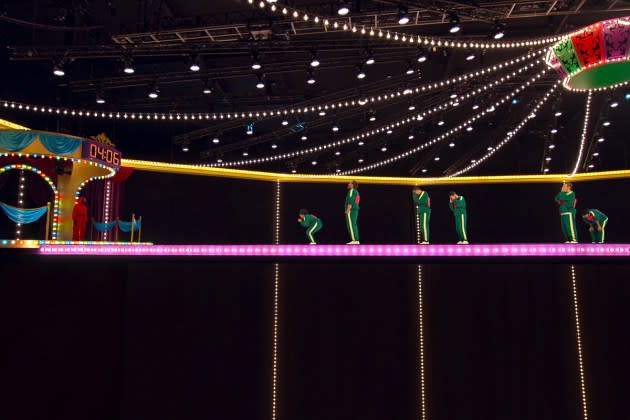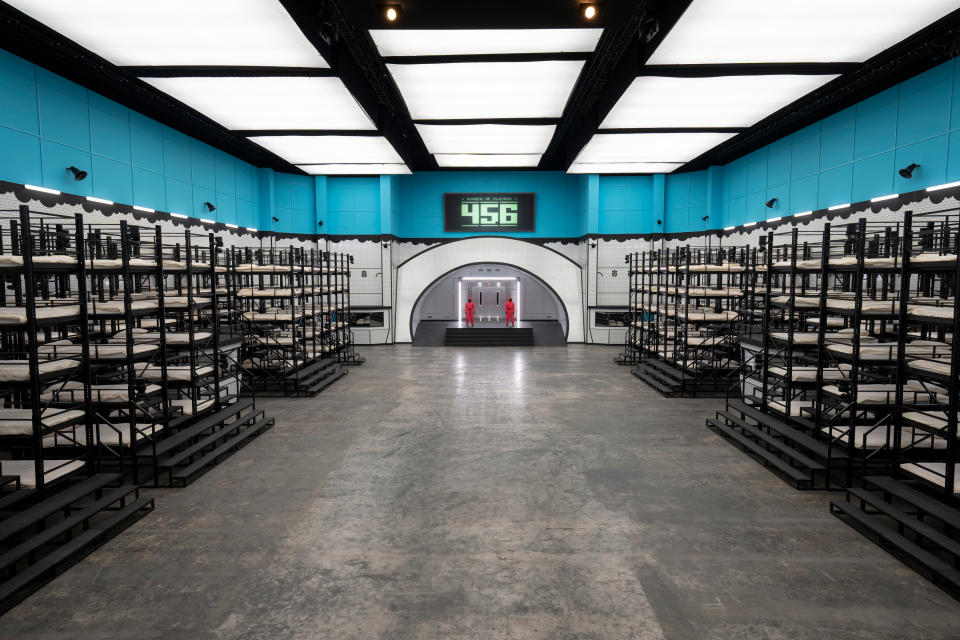How ‘Squid Game: The Challenge’ Built a Killer Glass Bridge Replica That Was Safe for Real-Life Contestants

Trap doors were production design secrets when it came to building one of the toughest games on Netflix’s “Squid Game: The Challenge.” Games production designer Ben Norman needed to retain the look of the Netflix drama series while making the sets completely immersive for the players.
456 players suited in green tracksuits had to compete in a series of change and strategy games for a prize of $4.56 million. As with the original “Squid Game,” challenges include Green Light/Red Light, Mystery Telephone and even Kitchen Nightmares. As the players dwindled, the games got harder.
More from Variety
'Squid Game: The Challenge' Renewed for Season 2 at Netflix, Casting Now Open
Netflix, Pushing Into AVOD Fray, Plans New Ad Formats, 'Crown' Sponsorship Deals
In Episode 7 “Friend or Foe,” with just 20 players left, the Glass Bridge challenge required players to carefully choose a glass panel. Pick the wrong one and you fall off. Pick the right one and it’s onto the next panel.
Aside from having to construct the bridge, Norman had to figure out how the contestants would fall and what could be used to create the fall. Glass was out of the question. He looked at using safety glass, but those had flaws.
“If it doesn’t break into smaller pieces, you could hurt someone,” Norman explains over a Zoom call from London. “We looked at sugar glass — the kind used in films, but it doesn’t work because you can never get the clarity.”
He ended up using Perspex, an acrylic-type material were used. The bridge itself was constructed from steel. Norman and his team worked with an engineering company to rig the bridge and help with the base structure. “It’s a big truss rig with support legs. On top of that is a big deck that has the trap doors that are all automated with a locking and safety mechanism.”
The use of trap doors was the only feasible way to have players fall through the glass.
Norman explored numerous solutions for the landing material. Foam pits were unsafe and were “dirty and expensive.” Stunt airbags also posed problems.
“Once you’ve done a drop, they deflate instantly, and you have to wait for them to reinflate and be safe. Also, you can’t have multiple people drop onto them,” he says.
He ended up working with a company that specialized in stunt bags for extreme sports that had extra chambers. “They’re like a spring mattress, so two people can drop simultaneously and they don’t affect one another.”
With all the technicalities resolved, Norman had to make everything look real. With the bridge suspended 16 feet off the ground, the studio was dark and the floors painted black. To the naked eye, “It looked like stepping stones. In a dark studio, you can’t tell how high they are.”
Even though there were safety mechanisms in place, a stunt person stepped in and was recorded falling.

Another set that required heavy lift was the dorm. Mathieu Weekes, the show’s main production designer, had to build the dorm room. Between tiling and 456 bunk beds, he had his work cut out for him.
“There were a lot of significant accent props or pieces that were very specific to Korea that we couldn’t get in the U.K., so we had to think outside the box,” Weekes says.
For the beds, he approached an industrial racking company to create bespoke parts. “We asked them to make ours in black and send them out to us so we could make our bedframes,” Weekes says.
Every time someone went off to play the next game, Weekes and his team were reconfiguring the layout of the beds. “We’d have the crew move the beds into different spaces and remove beds to discombobulate the players. So when they came back, it was a completely different layout.”

Best of Variety
Sign up for Variety’s Newsletter. For the latest news, follow us on Facebook, Twitter, and Instagram.

 Yahoo Movies
Yahoo Movies 
